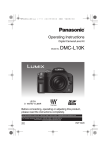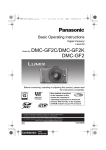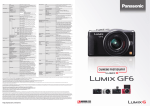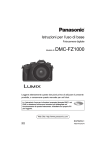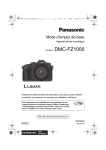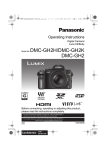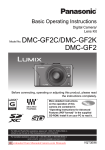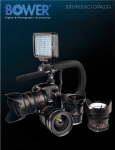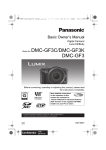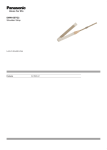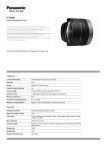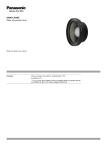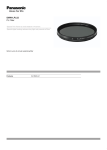Download Panasonic DMW-LA2 camera lens adapter
Transcript
http://panasonic.net/lumix Infinite Expressive Power... from a Small, Handy Lens "Single-lens reflex cameras are too big, heavy and hard to use." Not anymore. Panasonic disproves this old notion with the new LUMIX G Micro System, a superb new digital camera based on the Micro Four Thirds System standard. The camera body and all interchangeable lenses have been downsized, resulting in a camera that is revolutionary in size and weight. Yet image quality is remarkably high, thanks to a fusion of advanced optical technologies and industry-leading digital technologies. The LUMIX G Micro System renders superb images across a broad range of shooting situations, from wide-angle to telephoto. The LUMIX G Micro System also lets you enjoy the exciting new world of HD movie recording. Its high-performance features let you shoot your own movies with levels of clarity and beauty simply unimaginable in digital SLR cameras even a few years ago. Carry the small, lightweight LUMIX G Micro System everywhere you go. Change lenses as the inspiration moves you. Capture the beauty of both special places and everyday moments in stunning images you'll enjoy forever. With the LUMIX G Micro System, Panasonic introduces the ideal tool for exploring today's new digital imaging culture. It's a small camera with small lenses that put infinite expressive power in your hands. •Micro Four Thirds™ and the Micro Four Thirds logo mark are trademarks or registered trademarks of Olympus Imaging Corporation, in Japan, the United States, the European Union and other countries. 02 03 Huge Performance from Ultra-Compact Lenses A Breakthrough in Size and Weight: Mirrorless Configuration In developing the LUMIX G Micro System, A Digital Design that Delivers Beautiful Images from Corner to Corner High-Precision, High-Speed Contrast Auto Focus HD Movie Shooting – A New Way to Get Creative When a 35mm camera lens is used on a digital SLR The LUMIX G Micro System uses The LUMIX G Micro System camera, sharpness and light intensity can be lost a contrast auto focus (AF) system, not only shoots stunning and colors can bleed at the frame edges, where light which maximizes the use of Full- HD movies, it also features enters at an angle. Wide-angle lenses are especially time Live View. Panasonic expanded the industry's first auto problematic since oblique light inclined at a large angle the number of mount signal focus lens that works when compact and lightweight. The LUMIX G tends to enter the peripheral areas. Not with LUMIX contacts from 9 (the number used shooting movies. And to Micro System's mirrorless configuration G lenses. Created exclusively for digital use, LUMIX G in the Four Thirds System standard) to 11, to improve help you make even better Panasonic set out to create a digital Mirror Box SLR camera system with truly superior mobility. This meant that both the camera body and all lenses had to be extremely Four Thirds Flange back achieves exactly that, cutting the flange lenses are designed so that light can enter only from data transmission efficiency between lens and body. This movies, Panasonic has Micro Four Thirds Flange back straight ahead. You get superb rendering, with images helps achieve a contrast AF with levels of precision and introduced "silent design" lenses. These lenses use a the body mount radius by 6 mm. With the LUMIX G Micro that are bright, sharp and vivid all the way to the corners. speed never before seen in a digital SLR camera. linear motor, so no drive sounds from the auto focus focal distance almost in half and reducing System, you get a camera that is light in your hands, easy system are recorded as you shoot. With the LUMIX G to maneuver, and a joy to use. And you get breathtaking pictures thanks to an image sensor that's identical in Rack Guide pole size to larger Four Thirds System standard cameras. 35mm format camera system Light rays Light rays Image sensor (Simulated image) LUMIX G Micro System 04 LUMIX G/LEICA DG lens design Image sensor Stepping motor in drive system Micro System, Panasonic opens the door to new kinds of image expression. Explore the art of photography and capture still shots of exquisite beauty. Or enjoy the fun of Focus lens unit shooting your own HD movies with a mobile, easy-to-use digital SLR camera. Guide pole (Simulated image) 35mm camera lens design •Four Thirds™ and Micro Four Thirds™, and the Four Thirds and Micro Four Thirds logo marks are trademarks or registered trademarks of Olympus Imaging Corporation, in Japan, the United States, the European Union and other countries. 05 INDEX WIDE ZOOM Page 08 LUMIX G VARIO 7-14mm / F4.0 ASPH. STANDARD ZOOM Page 10 LUMIX G VARIO 14-42mm / F3.5-5.6 ASPH. / MEGA O.I.S. From Wide-Angle to Telephoto, LUMIX G Lenses Have Got You Covered LUMIX G VARIO 14-45mm / F3.5-5.6 ASPH. / MEGA O.I.S. LUMIX G VARIO HD 14-140mm / F4.0-5.8 ASPH. / MEGA O.I.S. TELEPHOTO ZOOM Page 14 LUMIX G VARIO 45-200mm / F4.0-5.6 / MEGA O.I.S. Capturing vacation shots, composing a portrait, zooming in on the action... No matter where you are or what you're shooting, there's a LUMIX G lens that lets you get the perfect shot. LUMIX G VARIO 100-300mm / F4.0-5.6 / MEGA O.I.S. Combining superb image rendering with advanced features, these lenses help you unleash the LUMIX G Micro System's extraordinary potential. MACRO Page 18 LEICA DG MACRO-ELMARIT 45mm / F2.8 ASPH. / MEGA O.I.S. SINGLE FOCAL LENGTH LUMIX G 14mm / F2.5 ASPH. LUMIX G 20mm / F1.7 ASPH. Page 20 LUMIX G FISHEYE 8mm / F3.5 How to Choose Lenses Page 26 Lens Knowledge Page 28 Lens Technology Page 30 Specifications Page 32 LUMIX Four Thirds Lenses / Optional Accessories Page 34 3D Lens 06 Page 35 07 WIDE ZOOM 7-14 mm F4.0 (35mm camera equivalent: 14-28mm) Standard (35mm camera equivalent: 40mm) 14mm (35mm camera equivalent: 28mm) 7mm (35mm camera equivalent: 14mm) The 14mm setting (35mm camera equivalent: 28mm) makes it easy to fit the whole subject in the image, even the parts a standard lens cuts off. The 7mm setting (35mm camera equivalent: 14mm) goes even further, providing a wide, sweeping view that gathers in more than the human eye can see at once. This is especially useful for shooting expansive landscapes on trips, or for fitting more into an indoor shot. LUMIX G VARIO 7-14mm / F4.0 ASPH. A Super Small, Lightweight Ultra-Wide-Angle Zoom Lens *As of March 25, 2009, for wide-angle zoom lenses for digital SLR cameras •Lens construction = 16 elements in 12 groups •Closest focusing distance = 0.25 m / 0.8 ft. •Maximum image magnification = 0.08x (35mm equivalent: 0.15x) •Dimensions = 70 (dia.) x 83.1 mm / 2.76 (dia.) x 3.27 in. •Weight = 300 g / 10.58 oz. •Accessories = Hood (built-in), case MTF Chart 20S MTF (%) 100 7mm F4.0 0 5 10 Distance from image center (mm) ASPH 08 ED 40S 40M 100 50 0 20M MTF (%) 1/200 sec, F8.0 As I held the camera to my eye, I viewed a suspension bridge gleaming in the morning sun, with the background stretching to the horizon. Capturing stunning images like this – with a dynamic perspective and fine details that I can't even see with the naked eye – is what makes photography such a captivating art. This lens – the world's smallest of its kind* – gives you an extraordinary perspective with its 114º diagonal angle of view. Small and light enough to take anywhere you go, this ultra-wide-angle lens lets you capture the vastness and majesty of sweeping landscapes with true-to-life ambience and perspective while traveling. In addition to two aspherical lenses for correcting a variety of aberrations, the lens is generously equipped with four extra-low dispersion (ED) lenses to eliminate chromatic aberration from magnification. It renders sharp, crisp image across the entire zoom range. 50 0 14mm F4.0 0 5 10 Distance from image center (mm) For the lens distortion compensation available, the horizontal axis of MTF is the distance from the center, which is compensated accordingly. 09 STANDARD ZOOM 14-42mm F3.5-5.6 /14-45mm F3.5-5.6 (35mm camera equivalent: 28-84mm) (35mm camera equivalent: 28-90mm) With an angle of view and perspective close to those of the human eye, this lens captures natural-looking, true-to-life images. Use it for almost any kind of shot – from landscapes to snapshots, children, pets, still-life objects and more – and enjoy the kind of beautifully rendered, breathtaking images you simply can't get with a compact camera. Versatile, High-Quality Standard Zoom Lens From Wide Angle to Medium Telephoto The standard zoom lens covers a lot of ground, extending from 28mm (35mm camera equivalent) to a zoom ratio of around 3.2x. With a total of 12 lens elements in 9 groups, including aspherical lenses, this high-quality lens delivers an excellent optical performance, correcting various aberrations and providing superb balance. This lens has all the versatility you need for both everyday shooting and artistic photography. As your shooting skills evolve, you'll find it easy to create interesting, expressive photos by varying the angle of view and focal distance, choosing different perspectives, and experimenting with varying degrees of soft focusing. LUMIX G VARIO 14-42mm / F3.5-5.6 ASPH. / MEGA O.I.S. •Lens construction = 12 elements in 9 groups •Closest focusing distance = 0.3 m / 1 ft. •Maximum image magnification = 0.16x (35mm equivalent: 0.32x) •Filter size = 52 mm •Dimensions = 60.6 (dia.) x 63.6 mm / 2.39 (dia.) x 2.50 in. •Weight = 165 g / 5.82 oz. •Accessories = Hood, case LUMIX G VARIO 14-45mm / F3.5-5.6 ASPH. / MEGA O.I.S. •Lens construction = 12 elements in 9 groups •Closest focusing distance = 0.3 m / 1 ft. •Maximum image magnification = 0.17x (35mm equivalent: 0.34x) •Filter size = 52 mm •Dimensions = 60 (dia.) x 60 mm / 2.36 (dia.) x 2.36 in. •Weight = 195 g / 6.88 oz. •Accessories = Hood, case LUMIX G VARIO 14-42mm / F3.5-5.6 ASPH. / MEGA O.I.S. 40S MTF Chart 40M 14mm F3.5 0 5 10 Distance from image center (mm) 50 0 20S 100 MTF (%) MTF (%) MTF (%) 20M 100 50 0 ASPH 10 20S 100 42mm F5.6 For the lens distortion compensation available, the horizontal axis of MTF is the distance from the center, which is compensated accordingly. 14mm F3.5 0 5 10 Distance from image center (mm) ASPH 40S 40M 100 50 0 0 5 10 Distance from image center (mm) 20M MTF (%) MTF Chart 1/320 sec, F5.6 I just click the shutter to catch the look of joy in my child's face as she plays in the back yard. This lens captures super-fine detail – even individual eyelashes – while giving the background a soft, delicate focus. With this 40mm-class lens (35mm camera equivalent: 80mm), I can easily snap off a shot anytime – and catch beautiful, natural-looking portraits without even pausing in my conversation. LUMIX G VARIO 14-45mm / F3.5-5.6 ASPH. / MEGA O.I.S. 50 0 45mm F5.6 0 5 10 Distance from image center (mm) For the lens distortion compensation available, the horizontal axis of MTF is the distance from the center, which is compensated accordingly. 11 STANDARD ZOOM 14-140mm F4.0-5.8 (35mm camera equivalent: 28-280mm) Movie Support 14mm (35mm camera equivalent: 28mm) 140mm (35mm camera equivalent: 280mm) A pasture behind a barn, lit up by the late afternoon sun. Use the optical 10x zoom to move in for a close-up of a chestnut mare nibbling clover. With this lens, you can zoom in and out while shooting either a photo or a movie – so you can capture high-resolution shots of all kinds of scenes. LUMIX G VARIO HD 14-140mm / F4.0-5.8 ASPH. / MEGA O.I.S. Perfect for HD Movies: A 10x Optical Zoom that Takes You from Wide-Angle to Telephoto •Lens construction = 17 elements in 13 groups •Closest focusing distance = 0.5 m / 1.64 ft. • Maximum image magnification = 0.2x (35mm equivalent: 0.4x) •Filter size = 62 mm •Dimensions = 70 (dia.) x 84 mm / 2.76 (dia.) x 3.31 in. •Weight = 460 g / 16.2 oz. •Accessories = Hood, case MTF Chart 20S 100 14mm F4.0 0 5 10 Distance from image center (mm) ASPH 12 ED 40S 40M 100 50 0 20M MTF (%) 1/40 sec, F5.8 MTF (%) With this system camera in HD movie recording mode, I'm the director. I can shoot softly focused silhouette shots of a man in a back alley playing a sax, and record every note in clear, high-quality sound. This lens, designed especially for shooting HD movies, works silently, so it won't interfere with the audio. My movies sound as great as they look. This high-powered zoom lens extends from 28mm to 280mm (35mm camera equivalent). Two ED lenses and 4 aspherical lenses correct a variety of aberrations, helping render high-contrast, high-resolution images without false colors or distortion, from corner to corner across the entire zoom range. Featuring a linear motor and Inner Focus system, the auto focus system is extremely fast, accurate and nearly silent – ideal for shooting HD movies. Using a microstep system for the aperture drive further suppresses noise, and makes HD movies easier and more comfortable to shoot. 50 0 140mm F5.8 0 5 10 Distance from image center (mm) For the lens distortion compensation available, the horizontal axis of MTF is the distance from the center, which is compensated accordingly. 13 TELEPHOTO ZOOM 45-200mm F4.0-5.6 (35mm camera equivalent: 90-400mm) 45mm 200mm (35mm camera equivalent: 90mm) (35mm camera equivalent: 400mm) Use the 45mm setting (35mm camera equivalent: 90mm) to take impressive landscape shots. With the 200mm setting (35mm camera equivalent: 400mm), the background appears as if it were right behind your subject. The telephoto zoom lets you adjust the way you capture your images, depending on the subject and your intent. LUMIX G VARIO 45-200mm / F4.0-5.6 / MEGA O.I.S. An Easy-to-Use Zoom that Goes All the Way to 400mm Capture natural-looking portraits in the medium telephoto range, or zoom all the way to 200mm (35mm camera equivalent: 400mm) to move in and grab dynamic action shots at sports events. This zoom lens covers a huge amount of ground. And with 16 elements in 13 groups, including 3 ED lenses, it corrects various aberrations with excellent balance to deliver images of stunning power and beauty. The unique Inner Focusing system allows high-speed contrast AF, and the 7-blade circular aperture renders images with a beautiful soft focus. •Lens construction = 16 elements in 13 groups •Closest focusing distance = 1.0 m / 3.3 ft. • Maximum image magnification = 0.19x (35mm equivalent: 0.38x) •Filter size = 52 mm •Dimensions = 70 (dia.) x 100 mm / 2.76 (dia.) x 3.94 in. •Weight = 380 g / 13.4 oz. •Accessories = Hood, case MTF Chart 20S 14 1/320 sec, F5.6 45mm F4.0 0 5 10 Distance from image center (mm) ED 40S 40M 100 50 0 20M MTF (%) Only 100mm long, this compact lens fits right in the palm of my hand – yet packs the power of a 400mm lens (35mm camera equivalent) to let me capture dynamic, professional-looking telephoto shots. I get the mobility I need to follow my child as he kicks a ball around a soccer field, and the power to zoom in for dramatic close-ups of his expressions. MTF (%) 100 50 0 200mm F5.6 0 5 10 Distance from image center (mm) For the lens distortion compensation available, the horizontal axis of MTF is the distance from the center, which is compensated accordingly. 15 TELEPHOTO ZOOM 100-300mm F4.0-5.6 (35mm camera equivalent: 200 - 600mm) 1/2000 sec, F5.6 Conventional 600mm-class (35mm camera equivalent) lenses are big, heavy and tiresome to haul around. LUMIX G lenses are small, lightweight and fit perfectly in the palm of the hand. Now, holding the camera in the hand, you can take dynamic, professional-looking ultratelephoto shots of a swimmer – and capture even individual drops of water flying through the air. LUMIX G VARIO 100-300mm / F4.0-5.6 / MEGA O.I.S. An Ultra-Zoom Lens that Fights Hand-Shake Drawing subjects in from a distance, this ultra-telephoto zoom lens is ideal for capturing intense action sports or animals you can't normally approach. An ED lens in the first lens group corrects the color bleeding that can occur when zooming, helping achieve consistently superb performance over the entire zoom range. The Inner Focus system teams up with a system that shifts a pair of lenses to enhance focusing, making possible high-speed contrast AF and excellent rendering at all zoom levels. This is in addition to MEGA O.I.S., an optical image stabilizing system that corrects for even slight hand-shake, making it easy to get clear, blur-free shots even at full zoom. •Lens construction = 17 elements in 12 groups •Closest focusing distance = 1.5 m / 4.92 ft. • Maximum image magnification = 0.21x (35mm equivalent: 0.42x) •Filter size = 67 mm •Dimensions = 73.6 (dia.) x 126 mm / 2.90 (dia.) x 4.96 in. •Weight = 520 g / 18.3 oz. •Accessories = Hood, case MTF Chart 40S 40M 100 MTF (%) 50 0 100mm F4.0 0 5 10 Distance from image center (mm) ED 16 20M 1/80 sec, F5.6 MTF (%) As I zoom into a shadow moving up a tree, suddenly a squirrel comes into view. I get incredibly clear, sharp zoom shots even with handheld shooting. I can see everything – whiskers, fur, the gleam in its eyes – with a level of detail and clarity that far exceed what I can see with the naked eye. 20S 100 50 0 300mm F5.6 0 5 10 Distance from image center (mm) For the lens distortion compensation available, the horizontal axis of MTF is the distance from the center, which is compensated accordingly. 17 MACRO 45mm F2.8 (35mm camera equivalent: 90mm) This macro lens does much more than make small things bigger. Not limited to beautiful soft focusing, it lets you bring the entire frame _ from corner to corner _ into sharp focus. That gives you the freedom to create a wide variety of compositions, from portraits to telephoto shots to landscapes, making this lens a true all-round performer. LEICA DG MACRO-ELMARIT 45mm / F2.8 ASPH. / MEGA O.I.S. A Superior Macro Lens Brings Tiny Worlds into View Designed and manufactured to meet Leica's stringent performance standards, this high-quality macro lens minimizes distortion, ghosts, flaring and decreased peripheral resolution. With 14 elements in 10 groups, including one aspherical lens and one ED lens, it provides stable contrast and high resolution all the way from 1:1 macro (35mm camera equivalent: 2x) to infinity. By using a floating Inner Focus system that shifts three groups of lenses, the elaborate focusing that's so essential to a macro lens has become both faster and quieter. Also featured is MEGA O.I.S., which fights blurring from hand-shake to help you capture clear, sharp images with everything from macro and medium-telephoto portraits to wide landscapes and long telephoto shots. 1/200 sec, F2.8 MTF Chart 20S 20M 40S 40M 100 MTF (%) As I stand captivated by this single flower glistening with morning dew, the macro lens turns it into a striking, dramatic image. Its superb rendering performance is seen here in the light transparency that has the look of a watercolor painting, the soft, delicate background focus, and the true-to-life droplets. Images like these reflect the breathtakingly beautiful imaging that distinguishes Leica. •Lens construction = 14 elements in 10 groups •Closest focusing distance = FULL: 0.15 m / 0.50 ft. LIMIT: 0.5 m / 1.64 ft. •Maximum image magnification = 1.0x (35mm equivalent: 2.0x) •Filter size = 46 mm • Dimensions = 63 (dia.) x 62.5 mm / 2.48 (dia.) x 2.46 in. •Weight = 225 g / 7.94 oz. •Accessories = Hood, case 50 45mm F2.8 0 0 5 10 Distance from image center (mm) ASPH ED For the lens distortion compensation available, the horizontal axis of MTF is the distance from the center, which is compensated accordingly. •LEICA is a registered trademark of Leica Microsystems IR GmbH. ELMARIT is a registered trademark of Leica Camera AG. The LEICA DG lenses are manufactured using measurement instruments and quality assurance systems that have been certified by Leica Camera AG based on the company's quality standards. 18 19 SINGLE FOCAL LENGTH 14mm F2.5 (35mm camera equivalent: 28mm) 1/8 sec, F2.5 With its fully open brightness, this lens is ideal for nightscapes. It lets in a large amount of light, so you can raise the shutter speed without increasing the ISO sensitivity. This wide-angle lens also suppresses hand-shake and noise, so all your shots are crisp, clear and beautiful. LUMIX G 14mm / F2.5 ASPH. Single-Focal-Length Lens for Wide-Angle Shooting A wide angle of view and outstanding depth of field make this pancake type wideangle lens a good choice for both snapshots and landscapes. Rendering highcontrast images across the entire frame and correcting distortion, this super-thin lens is especially ideal for capturing subjects that are primarily linear, such as buildings with a number of straight lines. Its simple lens construction - 6 elements in 5 groups, including 3 glass aspherical lenses – allows both high performance and an astonishingly compact size. •Lens construction = 6 elements in 5 groups •Closest focusing distance = 0.18 m / 0.59 ft. • Maximum image magnification = 0.10x (35mm equivalent: 0.20x) •Filter size = 46 mm •Dimensions = 55.5 (dia.) x 20.5 mm / 2.19 (dia.) x 0.81 in. •Weight = 55 g / 1.9 oz. •Accessories = Case MTF Chart 20S 20M 40S 40M Today, I'm visiting an old-time country stable. Thankfully this small lens sees everything, from the horse carriage in the corner to the thick wooden beams in the ceiling, all in a single frame. I'm able to capture the nostalgic air of a place time forgot with this slim, wide-angle 14mm pancake lens (35mm camera equivalent: 28mm). 20 MTF (%) 100 1/13 sec, F8.0 50 0 14mm F2.5 0 5 10 Distance from image center (mm) ASPH For the lens distortion compensation available, the horizontal axis of MTF is the distance from the center, which is compensated accordingly. 21 SINGLE FOCAL LENGTH 20mm F1.7 (35mm camera equivalent: 40mm) The smaller the F-number, the shallower the depth of field (the range in which things are in focus); the larger the F-number, the greater the depth of field. This lens, with its bright, fully open F1.7 aperture, lets you capture the desired parts of an image in sharp focus, while giving other parts a soft focus. This makes the subject really stand out, adding a rich expressiveness to the photo. F1.7 F16 LUMIX G 20mm / F1.7 ASPH. Compact Lens with Large F1.7 Aperture – Perfect for Everyday Shooting Featuring the brightness of an F1.7 aperture, this single-focal-length lens lets you capture beautiful, expressive images with a delicate soft focus and high contrast. Two aspherical lenses are perfectly configured to deliver enhanced performance in a compact system. With this thin, pancake lens mounted, the LUMIX G Micro System is easy to carry anywhere. You're always ready for whatever inspires the photographer inside you – everyday scenes, passing landscapes, indoor shots in dim lighting, casual snapshots, or artistic shots with soft focusing. •Lens construction = 7 elements in 5 groups •Closest focusing distance = 0.2 m / 0.66 ft. •Maximum image magnification = 0.13x (35mm equivalent: 0.25x) •Filter size = 46 mm •Dimensions = 63 (dia.) x 25.5 mm / 2.48 (dia.) x 1.00 in. •Weight = 100 g / 3.53 oz. •Accessories = Case MTF Chart 20S 20M 40S 40M As I casually snap shots of an unusual gate at a street corner, I use the F1.7's delicate soft focus to emphasize the texture of the rusty metal, and transform an everyday scene into a work of art. This lens has the power to give form to all of my artistic visions. MTF (%) 100 1/250 sec, F1.7 0 20mm F1.7 0 5 10 Distance from image center (mm) ASPH 22 50 For the lens distortion compensation available, the horizontal axis of MTF is the distance from the center, which is compensated accordingly. 23 SINGLE FOCAL LENGTH FISHEYE 8mm F3.5 (35mm camera equivalent: 16mm) With a fisheye lens, familiar everyday scenes become surreal, imaginative images. Even with the same subject, changing the lens angle creates a curving effect that gives the scene an entirely different look. Whether you're shooting photos or movies, the fisheye lens lets you create truly distinctive eye-catching images. Depression angle Horizontal angle Elevation angle LUMIX G FISHEYE 8mm / F3.5 Fisheye Lens for Unique Images with Intriguing Deformation Effects This fisheye lens with equisolid angle projection lets you create fascinating images with a 180º diagonal angle of view and intriguing deformation effects. Featuring 10 elements in 9 groups, including 1 ED lens, this lens system corrects chromatic aberration from magnification and other sources, to assure superb image rendering. The fisheye lens also features the Inner Focus system, as well as a virtually silent single-lens drive system that won't interfere with the sound you're recording when using the LUMIX G Micro System to shoot HD movies. •Lens construction = 10 elements in 9 groups •Closest focusing distance = 0.1 m / 0.33 ft. • Maximum image magnification = 0.20x (35mm equivalent: 0.40x) •Filter size = Front: Mounting not possible / Rear: Sheet filter holder 22 mm / 0.86 in x 22 mm / 0.86 in. •Dimensions = 60.7 (dia.) x 51.7 mm / 2.39 (dia.) x 2.04 in. •Weight = 165 g / 5.82 oz. •Accessories = Case MTF Chart 20S 20M 40S 40M 100 24 3.2 sec, F10 MTF (%) At 180º, the angle of view is far beyond what I can take in with normal eyesight. That's the appeal of a fisheye lens. This unique lens lets me capture surreal-looking images with a powerful perspective and deformation effect, yet portray even the lights of a building at night in clear detail. 50 0 8mm F3.5 0 5 10 Distance from image center (mm) ED For the lens distortion compensation available, the horizontal axis of MTF is the distance from the center, which is compensated accordingly. 25 How to Choose Lenses Tips on selecting the most suitable lens for your subject and shooting situation. for Landscapes The 7-14mm or 14mm pancake lens lets you emphasize the perspective and express how vast a particular landscape is. The 14-42mm or 14-45mm lens lets you capture medium telephoto shots that draw in distant landscapes. The 45mm macro lens maintains image sharpness all the way to the edges, even when shooting at infinity. for Animals When photographing indoor pets that won't sit still, the 20mm lens lets you shoot at faster shutter speeds, making it possible to capture sharp, bright shots. LUMIX G VARIO 7-14mm / F4.0 ASPH. LUMIX G 14mm / F2.5 ASPH. To photograph birds or other animals in the wild – when it would be dangerous or impossible to approach - use the 45-200mm or 100-300mm telephoto zoom lens. LUMIX G VARIO 14-42mm / F3.5-5.6 ASPH. / MEGA O.I.S. LUMIX G VARIO 14-45mm / F3.5-5.6 ASPH. / MEGA O.I.S. for Use the 45-200mm or 100-300mm telephoto zoom lens to capture dynamic action shots from the stands at a sports event or racetrack. The 14mm wide-angle pancake lens or 7-14mm ultra-wide-angle lens lets you fit more into the photo when shooting in tight spaces, such as at an indoor party or inside a car. The 14-42mm or 14-45mm standard zoom lens covers a wide range of uses, such as photographing landscapes and people during your travels. LUMIX G 20mm / F1.7 ASPH. for LUMIX G 14mm / F2.5 ASPH. for Portraits The large-aperture 45mm or 20mm pancake lens lets you capture the subject in clear focus while softly blurring the background. LUMIX G VARIO HD 14-140mm / F4.0-5.8 ASPH. / MEGA O.I.S. LUMIX G VARIO 14-42mm / F3.5-5.6 ASPH. / MEGA O.I.S. Close-up Shots The 45mm macro can render superb close-ups of small, detailed objects, such as flowers, insects or jewelry. The 14-42mm, 14-45mm, and 14-140mm lenses let you capture natural-looking portraits from a medium distance while talking to your subject. LUMIX G VARIO 45-200mm / F4.0-5.6 / MEGA O.I.S. Events The 14-140mm 10x optical zoom lens has the versatility to handle a wide range of shots. And you can use it not only to capture stunning photos, but when shooting HD movies too. LUMIX G VARIO 7-14mm / F4.0 ASPH. LUMIX G VARIO 14-45mm / F3.5-5.6 ASPH. / MEGA O.I.S. for LUMIX G VARIO 100-300mm / F4.0-5.6 / MEGA O.I.S. LUMIX G VARIO 100-300mm / F4.0-5.6 / MEGA O.I.S. Traveling and Casual Snapshots The 20mm pancake lens is always ready to grab photos on the fly. LUMIX G VARIO 45-200mm / F4.0-5.6 / MEGA O.I.S. Sports and Vehicles LEICA DG MACRO-ELMARIT 45mm / F2.8 ASPH. / MEGA O.I.S. for LUMIX G 20mm / F1.7 ASPH. To capture detailed views of faraway objects – for example, the engravings o n a d i sta n t b u i l d i n g - u s e t h e 45-200mm or 100-300mm lens. LUMIX G VARIO 14-42mm / F3.5-5.6 ASPH. / MEGA O.I.S. LUMIX G VARIO 14-45mm / F3.5-5.6 ASPH. / MEGA O.I.S. LUMIX G VARIO HD 14-140mm / F4.0-5.8 ASPH. / MEGA O.I.S. LEICA DG MACRO-ELMARIT 45mm / F2.8 ASPH. / MEGA O.I.S. for Unique Shots The 8mm fisheye and 7-14mm ultrawide-angle lens let you capture distinctive, intriguing shots with unusual deformation effects. You can use them for both photos and movies. LEICA DG MACRO-ELMARIT 45mm / F2.8 ASPH. / MEGA O.I.S. LUMIX G VARIO 45-200mm / F4.0-5.6 / MEGA O.I.S. LUMIX G VARIO 100-300mm / F4.0-5.6 / MEGA O.I.S. LUMIX G FISHEYE 8mm / F3.5 LUMIX G VARIO 7-14mm / F4.0 ASPH. LUMIX G 20mm / F1.7 ASPH. 26 27 Lens Knowledge Things you should know about lenses to maximize your photographic enjoyment. 180° FISHEYE 8mm (16mm) 34° 35mm (70mm) 7mm (14mm) 29° 42mm (84mm) 114° What are angle of view and focal length? What's perspective? What's MTF? The angle of view is the area of the image captured by the image sensor, expressed as an angle. The larger the angle of view, the shorter the focal length. The smaller the angle of view, the longer the focal length. A lens with a short focal length and a large angle of view is called a wide-angle lens. A lens with a long focal length and a small angle of view is called a telephoto lens. In the LUMIX G Micro System, the diagonal dimension of the image sensor has been downsized to half that of a 35mm film frame, so the focal length is twice as long when converted to that of a 35mm camera. For example, the angle of view for a LUMIX G 25mm lens is 47º, which is the same as the angle of view for a 50mm lens on a 35mm camera. Perspective refers to the relationship between nearby and distant objects. A wide-angle lens makes objects close to the lens appear larger and faraway objects smaller. This emphasizes the distance (depth) between nearby and distant objects, making the background appear farther away and expansive. A telephoto lens, on the other hand, compresses the perspective, thus deemphasizing the distance between objects in the foreground and objects in the background. MTF stands for Modulation Transfer Function. It's one of the indexes used to describe lens performance. The MTF is a numerical value that indicates how accurately a lens can reproduce the contrast of an object. The vertical axis of the graph shows contrast reproducibility (%), while the horizontal axis indicates the distance (mm) from the image center. The image quality is evaluated in the sagittal direction "S" (parallel to the radius of the image circle) and in the meridional direction "M" (radial direction) using two frequencies (high frequency: 40 lines/mm, low frequency: 20 lines/mm). The solid lines represent sagittal measurements, and the dotted lines indicate meridional measurements. The higher up (100%) the graph, the better the image rendering capability of the lens. The higher the measurements with the low frequency, the higher 100 90 80 the contrast reproduction 70 capability. The higher the 60 50 measurements with the high 40 30 frequency, the higher the 20 10 resolving power. •Micro Four Thirds™ and the Micro Four Thirds logo mark are trademarks or registered trademarks of Olympus Imaging Corporation, in Japan, the United States, the European Union and other countries. 14mm (28mm) 25mm (50mm) 100° 84° 9mm (18mm) 12mm (24mm) 27° 12° 45mm (90mm) 100mm (200mm) Lens brightness is determined by the focal length and effective lens diameter. If you divide the focal length by the effective lens diameter, you get a value called the F-number. The smaller the F-number, the brighter the lens (the larger the aperture). A bright lens has several key advantages. For example, a brighter lens lets you use a faster shutter speed, so you can get clear, blurfree shots even in dim lighting. It also lets you give the background a soft focus. What's depth of field? 75° 57° 14mm (28mm) 20mm (40mm) 8.8° 6.2° 140mm (280mm) 200mm (400mm) Depth of field is the range of object distances (in the depth direction) within which objects have acceptable sharpness. A long focal length (telephoto lens) or small F-number (bright lens) makes the depth of field shallower. A short focal length (wide-angle lens) or large F-number (dark lens) makes the depth of field greater. With a shallow depth of field, it's easier to take pictures in which the background is intentionally given a soft focus, thus emphasizing the sharp subject focus. With a large depth of field, you can keep objects in the foreground and objects in the background all in focus (for a pan-focus effect). MTF (%) What's the F-number? 0 28 25mm (50mm) 4.1° 300mm (600mm) *Figures in parentheses are 35mm camera equivalent values. F2.8 F22 2 4 6 8 10 Distance from image center (mm) 45mm (90mm) S: 20 lines/mm S: 40 lines/mm 100mm (200mm) M: 20 lines/mm M: 40 lines/mm *Figures in parentheses are 35mm camera equivalent values. Lens Designation What's the magnification ratio? The magnification ratio is a numerical value that indicates the size difference between the actual size of an object and the size of that object captured on the image sensor. For example, if a 10-mm object is captured in a 5-mm size on the i m a g e s e n s o r t h ro u g h a lens, that lens has a magnification ratio of 0.5x. If the object is captured in a 10-mm size, the lens has a magnification ratio of 1.0x, which is also referred to as "1:1." LUMIX G VARIO 14-45mm / F3.5-5.6 ASPH./ MEGA O.I.S. 1 1 2 3 4 Focal length The smaller the focal length, the wider the angle of view (wide angle). The larger the focal length, the smaller the angle of view (telephoto). The number on the left is the focal length at the wide-angle setting, and the number on the right is the focal length at the telephoto setting. 0.25x 2 F-number The smaller the F-number, the brighter the lens. The number on the left is the F-number for the fully opened aperture at the wide-angle setting, and the number on the right is the F-number for the fully opened aperture at the telephoto setting. (The F-number takes an intermediate value while zooming.) 0.5x 3 Aspherical lens "ASPH." means that the lens includes one or more aspherical lenses. 4 *The maximum image magnification of a Micro Four Thirds System lens can be converted into the maximum image magnification of a 35mm camera lens by multiplying "the indicated maximum image magnification x 2". 47° 0 Hand-shake compensation "MEGA O.I.S." indicates that the lens is equipped with an optical image stabilizer for hand-shake compensation. 1.0x 29 Lens Technology These cutting-edge technologies support the compact size, light weight, and high-quality images of the LUMIX G Lenses Manufactured with Uncompromising Devotion to High Image Quality The LUMIX G/LEICA DG lenses are manufactured by an integrated production system in the Panasonic Yamagata Plant in Japan. From lens processing to assembly, inspection, and individual packaging, all processes are conducted in Clean Rooms according to rigorous environmental standards. For example, to inspect aspherical lenses, we use an instrument called the UA3P Ultra-Accurate 3D Profilometer, which was originally developed by Panasonic and now plays an essential role in the development and manufacturing activities of many optical device manufacturers. Using this instrument, with its measurement accuracy of 1/10,000 mm, we conduct objective, numerical evaluations. These criteria are then used to determine the presence of flaring, the color of coatings, the operating feel of the focus ring, etc., in order to ensure high-quality production control. As a result, the quality of Panasonic lenses has gained high worldwide acclaim for accuracy and image quality. Micro System. MEGA O.I.S. (Optical Image Stabilizer) Aspherical Lenses The smaller and lighter the camera body, the greater the hand-shake effect during shooting. LUMIX G/LEICA DG lenses feature MEGA O.I.S., an image stabilizing function that has been highly evaluated by compact camera users. An internal LSI processes the output of the system's gyro sensors approximately 4,000 times a second to provide accurate compensation for even tiny amounts of handshake. Unlike image stabilizing functions that are built into the camera body, this highly accurate function also lets you check the compensation effect directly through the Live View Finder or on the LCD. The images that you capture have the same shake-free beauty as what you see on the Live View Finder or the LCD. The compensation effect is also carefully matched to each lens. MEGA O.I.S. is especially effective for hand-held shooting with a zoom lens. To assure superior image quality while reducing size and weight, each LUMIX G/LEICA DG lens features a number of aspherical lenses that effectively prevent lens aberration, such as spherical and distortion aberration. Each aspherical lens has the effect of several spherical lenses, so a higher magnification ratio can be achieved with fewer lenses. The result is smaller overall size and weight. Aspherical lenses are extremely difficult to produce, however, because they demand high dimensional accuracy. In the past this restricted the applicable lens shapes and materials, but Panasonic has made great strides in this area. Our Yamagata Plant began developing cutting-edge production technologies for molded lenses early on, and today the plant manufactures a wide variety of lenses – including concave lenses that have a large thickness difference and measure a mere 0.3 mm at the thinnest part. The aspherical lenses with superb image rendering ability produced at this plant now see widespread use. Multicoating Process An Original Lens Drive Motor for High-Precision, High-Speed Contrast AF In conventional digital SLR cameras, contrast AF is more accurate than phase difference AF, but it has a slower focus speed. LUMIX G/LEICA DG lenses overcome this problem by incorporating a unique stepping motor in the drive system. A screw unit integrated with the motor shaft moves the focus lens directly, without relay gears or cams. Auto focusing is swift and accurate. Some lens models are equipped with a linear motor to further reduce drive noise – ideal when recording movies with sound. The number of mount signal contacts has been increased from the 9 used in conventional Four Thirds System cameras to 30 11, so information transfer between lens and camera is faster. This has also helped achieve a contrast AF system that excels in both speed and accuracy. Rack Guide pole Stepping motor in drive system Utmost caution is exercised in coating the LUMIX G/LEICA DG lenses to suppress ghosts and flaring, while ensuring optimum color balance. In addition to a standard broadband anti-reflection coating, LUMIX G/LEICA DG lenses feature a coating that reduces the reflectance of light that enters at an angle. This multicoating process is widely used on lenses with a small radius of curvature, such as those in ultrawide-angle lenses and fisheye lenses. It greatly improves the image rendering performance when shooting against a light source. Moreover, the bonded surfaces of cemented lenses are also given an original multicoating process to further reduce reflection. This results in high-quality images with superb clarity. Focus lens unit Guide pole Without multicoating With multicoating Aspherical lens Spherical lens Extra-Low Dispersion Lenses In a conventional lens made only of optical glass, it becomes difficult to correct chromatic aberration when the focal length is long or the angle of view is wide, thus resulting in contrast degradation or color bleeding. This problem has been solved by Panasonic's Extra-Low Dispersion (ED) lens. It suppresses the prism's color separation effect to correct lo n g i t u d i n a l c h ro m a t i c aberration at the telephoto zoom setting and chromatic Chromatic difference of magnification aberration at the wide-angle setting. Normal lens The ED lens is used mainly in LUMIX G/LEICA DG telephoto lenses and wide-angle zoom lenses to render sharp, highcontrast images with clear Minimal chromatic colors from corner to corner. aberration ED lens 31 Specifications Micro Four Thirds System Standard Lens 35mm AF MEGA Lens Construction Angle Equivalent Actuator O.I.S. Elements-Groups of View Focal Length LUMIX G VARIO 7-14mm / F4.0 ASPH. 14-28mm Stepping Motor - 16-12 114°- 75° LUMIX G VARIO 14-42mm / F3.5-5.6 ASPH. / MEGA O.I.S. 28-84mm Stepping Motor • 12-9 75°- 29° Standard Zoom LUMIX G VARIO 14-45mm / F3.5-5.6 ASPH. / MEGA O.I.S. 28-90mm Stepping Motor • 12-9 75°- 27° Linear Motor • 17-13 75°- 8.8° Wide Zoom LUMIX G VARIO HD 14-140mm / F4.0-5.8 ASPH. / MEGA O.I.S. 28-280mm Single Focal Length Adaptor 3D 7 (Circular aperture diaphragm) 7 (Circular aperture diaphragm) 7 (Circular aperture diaphragm) 7 (Circular aperture diaphragm) Minimum Aperture Closest Focusing Distance (m / ft.) Maximum Image Magnification (35mm equivalent) Filter Size (mm) 22 0.25 / 0.8 0.08x (0.15x) - 70 x 83.1 / 22 0.3 / 1 0.16x (0.32x) 52 60.6 x 63.6 / 22 0.3 / 1 0.17x (0.34x) 52 60 x 60 / 22 0.5 / 1.64 0.2x (0.4x) 62 22 1.0 / 3.3 0.19x (0.38x) 22 1.5 / 4.92 22 Diameter ( ) x Length (mm / in.) Weight (g / oz.) Standard Accessories 300 / 10.58 Lens cap, Lens rear cap, Lens storage bag 165 / 5.82 Lens cap, Lens hood, Lens rear cap, Lens storage bag 2.36 x 2.36 195 / 6.88 Lens cap, Lens hood, Lens rear cap, Lens storage bag 70 x 84 / 2.76 x 3.31 460 / 16.2 Lens cap, Lens hood, Lens rear cap, Lens storage bag 52 70 x 100 / 2.76 x 3.94 380 / 13.4 Lens cap, Lens hood, Lens rear cap, Lens storage bag 0.21x (0.42x) 67 73.6 x 126 / 2.90 x 4.96 520 / 18.3 Lens cap, Lens hood, Lens rear cap, Lens storage bag 0.15 / 0.50 (FULL), 0.5 / 1.64 (LIMIT) 1.0x (2.0x) 46 63 x 62.5 / 2.48 x 2.46 225 / 7.94 Lens cap, Lens hood, Lens rear cap, Lens storage bag 22 0.18 / 0.59 0.10x (0.20x) 46 55.5 x 20.5 / 55 / 1.9 Lens cap, Lens rear cap, Lens storage bag 16 0.2 / 0.66 0.13x (0.25x) 46 63 x 25.5 / 100 / 3.53 Lens cap, Lens rear cap, Lens storage bag 22 0.1 / 0.33 0.20x (0.40x) *1 60.7 x 51.7 / 2.39 x 2.04 165 / 5.82 Lens cap, Lens rear cap, Lens storage bag 2.76 x 3.27 2.39 x 2.50 LUMIX G VARIO 45-200mm / F4.0-5.6 / MEGA O.I.S. 90-400mm Stepping Motor • 16-13 27°- 6.2° LUMIX G VARIO 100-300mm / F4.0-5.6 / MEGA O.I.S. 200-600mm Stepping Motor • 17-12 12°- 4.1° LEICA DG MACRO-ELMARIT 45mm / F2.8 ASPH. / MEGA O.I.S. 90mm Stepping Motor • 14-10 27° LUMIX G 14mm / F2.5 ASPH. 28mm Stepping Motor - 6-5 75° LUMIX G 20mm / F1.7 ASPH. 40mm Stepping Motor - 7-5 57° LUMIX G FISHEYE 8mm / F3.5 16mm Stepping Motor - 10-9 180° Mount Adaptor DMW-MA1 - - - - - - - - - - 71 x 24 / ( 2.80 × 0.94 ) 87 / 3.07 - M Mount Adaptor DMW-MA2M - - - - - - - - - - 61 x 13 / ( 2.40 × 0.51 ) 60 / 2.12 - R Mount Adaptor DMW-MA3R - - - - - - - - - - 67 x 33 / ( 2.64 × 1.30 ) 90 / 3.17 - 45 / 1.59 Lens cap, Lens rear cap, Lens storage bag Weight (g / oz.) Standard Accessories 490 / 17.3 Lens cap, Lens hood, Lens rear cap, Lens storage bag 434 / 15.3 Lens cap, Lens hood, Lens rear cap, Lens storage bag 535 / 18.9 Lens cap, Lens hood, Lens rear cap, Lens storage bag 510 / 18 Lens cap, Lens hood, Lens rear cap, Lens storage bag Telephoto Zoom Macro Number of Blades LUMIX G 12.5mm / F12 65mm*2 - - 4-3 x2 37°*2 7 (Circular aperture diaphragm) 7 (Circular aperture diaphragm) 7 (Circular aperture diaphragm) 7 (Circular aperture diaphragm) 7 (Circular aperture diaphragm) 7 (Circular aperture diaphragm) - - 0.6 / 1.97 0.02x (0.1x*2) - 57.0 x 20.5 / Minimum Aperture Closest Focusing Distance (m / ft.) Maximum Image Magnification (35mm equivalent) Filter Size (mm) 22 0.29 / 0.95 0.16x (0.32x) 72 78.1 x 97.4 / 22 0.29 / 0.95 0.21x (0.42x) 67 74 x 93 / 22 0.5 / 1.64 0.18x (0.36x) 72 78.5 x 90.4 / 16 0.38 / 1.25 0.09x (0.17x) 62 77.7 x 75 / 2.19 x 0.81 2.48 x 1.00 2.24 × 0.81 Four Thirds System Standard Lens 35mm AF MEGA Lens Construction Angle Equivalent Actuator O.I.S. Elements-Groups of View Focal Length Number of Blades LEICA D VARIO-ELMARIT 14-50mm / F2.8-3.5 ASPH. / MEGA O.I.S. 28-100mm DC Motor • 16-12 75°- 24° 7 (Iris diaphragm) Standard Zoom LEICA D VARIO-ELMAR 14-50mm / F3.8-5.6 ASPH. / MEGA O.I.S. 28-100mm DC Motor • 15-11 75°- 24° Supersonic Wave Motor • 15-11 75°- 8.2° DC Motor - 10-9 47° LEICA D VARIO-ELMAR 14-150mm / F3.5-5.6 ASPH. / MEGA O.I.S. 28-300mm Single Focal Length LEICA D SUMMILUX 25mm / F1.4 ASPH. 50mm 7 (Circular aperture diaphragm) 7 (Circular aperture diaphragm) 7 (Circular aperture diaphragm) Diameter ( ) x Length (mm / in.) 3.07 x 3.83 2.91 x 3.66 3.09 x 3.56 3.06 x 2.95 •The compression level of product photographs shown in this catalog varies. Check the above table for actual sizes. *1 Front: Mounting not possible, Rear: Sheet filter holder 22mm / 0.86 inch x 22mm / 0.86 inch *2 When setting the aspect ratio at 16:9 with the DMC-GH2 •Four Thirds™, Micro Four Thirds™, and the Four Thirds and Micro Four Thirds logo marks are trademarks or registered trademarks of Olympus Imaging Corporation, in Japan, the United States, the European Union and other countries. 32 33 LUMIX Four Thirds Lenses The optional DMW-MA1 Mount Adaptor also lets you use LEICA D lenses, which are renowned for their clarity and stunning image beauty. LEICA D VARIO-ELMARIT 14-50mm / F2.8-3.5 ASPH. / MEGA O.I.S. LEICA D VARIO-ELMAR 14-50mm / F3.8-5.6 ASPH. / MEGA O.I.S. LEICA D VARIO-ELMAR 14-150mm / F3.5-5.6 ASPH. / MEGA O.I.S. LEICA D SUMMILUX 25mm / F1.4 ASPH. •Four Thirds™ and the Four Thirds logo mark are trademarks or registered trademarks of Olympus Imaging Corporation, in Japan, the United States, the European Union and other countries. •Leica is a registered trademark of Leica Microsystems IR GmbH. Leica D lenses are manufactured using measurement instruments and quality assurance systems certified by Leica Camera AG to meet the company's quality standards. Optional Accessories Choose from a wide lineup of fun-enhancing accessories. PL Filter (Circular Type) ND (Neutral Density) Filter (ND8) 67mm DMW-LPL67 62mm DMW-LPL62 52mm DMW-LPL52 46mm DMW-LPL46 62mm DMW-LND62 52mm DMW-LND52 46mm DMW-LND46 Helps eliminate reflections while preserving the naturally vivid colors of the subject. Without PL filter With PL filter Lets you use slower shutter speeds even in the bright outdoors, and reduces light intensity by three aperture stops. Without ND filter With ND filter External TTL Flash Mount Adaptor GN22 DMW-FL220 GN36 DMW-FL360 GN50 DMW-FL500 DMW-MA1 for the Four Thirds System standard DMW-MA2M for M mount lens of Leica Camera AG DMW-MA3R for R mount lens of Leica Camera AG Provides perfect lighting for shots of slightly distant subjects in the dark. MC Protector Protects the camera lens from scratches and other damage. 67mm DMW-LMCH67 62mm DMW-LMCH62 52mm DMW-LMC52 46mm DMW-LMC46 HDMI Mini Cable Lets you send your photos and movies from the camera directly to an HDTV, with virtually no degradation. 1.5m RP-CDHM15 3.0m RP-CDHM30 Enables the use of lenses other than those of the Micro Four Thirds System standard. Stereo Microphone Ambient sounds can be clearly recorded in higher quality and from greater distances. DMW-MS1 Live View Finder The 202,000-dot equivalent Live View Finder attaches to the hot shoe. It is also handy for low-angle shots because it can be tilted vertically from 0 to 90 degrees. DMW-LVF1 Remote Shutter Allows remote operation of the shutter button when, for example, you are using a tripod. With shutter lock for bulb exposures. Battery Zoom Lever DMW-BLB13 DMW-BLC12 DMW-ZL1 Spare batteries for more shooting enjoyment. Lets you zoom in and out at a steady speed for movie recording. DMW-RSL1 •LUMIX G Micro System cameras come with a function to check whether the battery and unit can be safely used together. •Batteries made by other companies which have been certified by Panasonic may be used with these units, but we offer no guarantee as to the quality, performance or safety of such batteries. •Exercise care when purchasing batteries. Many fake or imitation batteries have been found among those sold at unusually low prices and those which customers cannot check for themselves before purchasing. •Please confirm the latest information about batteries on the following website. http://panasonic.jp/support/global/cs/info/battery.html (This website is in English only.) 34 The World's First* Interchangeable 3D Lens Once Again, the LUMIX G Micro System Dramatically Changes Digital SLR Shooting Styles. Colorful flowers, stunning portraits and striking landscapes captured by the camera seem to be standing right in front of your eyes. They form an entirely new world of images with their highly dimensional effects and sense of depth. By changing lenses to match your intent and the shooting situation, you can add a new form of 3D expression to the joy of creating superb images.** •Lens construction = 4 elements in 3 groups x2 •Closest focusing distance = 0.6 m / 1.97 ft. •Maximum image magnification = 0.02x (35mm equivalent: 0.1x***) •Dimensions = 57.0 (dia.) x 20.5 mm / 2.24 (dia.) x 0.81 in. •Weight = 45 g / 1.59 oz. •Accessories = Case *For a digital interchangeable lens as of September 21, 2010. **Available with some Panasonic cameras only. Compatible Olympus cameras not yet determined, as of September 2010. A 3D media player that supports the MP (Multi-Picture) format is required to view 3D images. ***When setting the aspect ratio at 16:9 with the DMC-GH2. •Micro Four Thirds™ and the Micro Four Thirds logo mark are trademarks or registered trademarks of Olympus Imaging Corporation, in Japan, the United States, the European Union and other countries. LUMIX G 12.5mm / F12 (35mm camera equivalent: 65mm***) 35


















